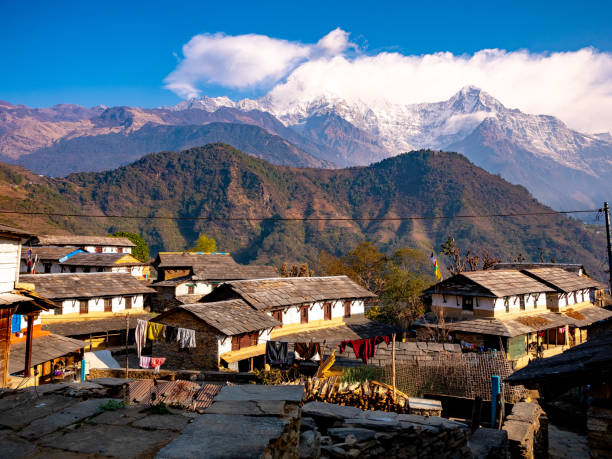How To Crush The Painful Climb To Annapurna With Grit
The journey to the Annapurna Himalaya is reputedly hard, physically, mentally, and emotionally. But it’s also one of the most rewarding challenges you can pursue. Conquering the arduous climb up Annapurna takes more than physical fitness;” it takes grit — a relentless resolve to press on even when every muscle screams, when the altitude robs you of breath and when doubt fills your brain. Here’s how to build that grit and get to the top of the mountain in the worst moments.
First, recognize that pain and suffering are part of the process. Rather than pushing away pain, welcome it as an indicator that you are growing stronger, moving forward, and heading right toward your goal. It’s all mental: Picture yourself getting over every hump, whether it’s a steep hill, bumpy terrain, or the altitude headache you developed 15 minutes ago. When your body protests, remind yourself why you set out and what lies on the other side of the next ridge. This act of mental rehearsal prepares your mind to anticipate struggle, helping you to approach obstacles with resilience rather than dread or frustration.
Then divide the climb into individual sections. When confronted with a daunting mountain, it’s easy to be intimidated. Don’t worry about how tough a climb you face, take it one step at a time — literally and figuratively in ABC Trek. “Forget about the finish line,” writes Chris Johnson, 40, of Ridgeland, South Carolina, when he runs. “Instead, break the run up into short, doable sections,” Chris recommends picking out an interim goal, like a big tree or a rock, and making that your finish line. Savour every victory – no matter how insignificant – because it is a victory and victories breed victories and keep you fired up. This baby-step approach transforms a daunting climb into a sequence of attainable goals, and it also helps you maintain motivation and spirits.
The hard work is, of course, getting your body into top shape. Get your stamina and strength on before through weekly cardio routines, hiking preparation, and strength training. On the trail, take it easy: Start slow and steady to save energy. Keep yourself well-hydrated and well-fed because altitude and effort require more fuel than you may think. Honor your body, but don’t be knocked off course by little things. Learn to tell the difference between normal tiredness and serious red alerts. You train correctly and race sensibly, and your body is your friend, not your enemy.
And perhaps most importantly, build the kind of support system you need. Whether it’s other trekkers, your guides, or the locals, it helps a lot to have people to cheer you on. Connect with them and confide in them, make them your celebration in the Annapurna Sanctuary. Their energy can relight you when it feels diminished. Sometimes, it can make all the difference to know that you’re not alone, and that others are going through the same thing that you’re going through — those who are waking up in the early morning to get up and hit the road.
Finally, think of the bigger picture, the spectacular views, the fact you’ve made it through, and you as a person growing from the challenge. Grit is not about quashing pain — it’s about using the pain to propel you into the air. Each sore muscle, every laboured step, all doubt quashed, is evidence of how tough you are. Yes, the climb to Annapurna is painful, but it is also a transformative one. For with grit, you don’t just conquer the climb — you go beyond it, stronger, wiser, terribly proud.
Get Your Body Ready through Muscle Workouts
Strengthening your body with resistance training is key to enduring tough treks such as the Annapurna Base Camp Trek. The ascension demands endurance, pain resistance, and physical well-being to overcome long days on unsteady ground. Strength training emphasizes developing your leg, core, and upper body muscles – essential for balance, stability, and power while hiking up and down steep hills. Exercises, such as the squat, lunge, step-up, and deadlift — which all strengthen the quads, hamstrings, gluteals, and calves, the major muscles used while hiking — are examples.
Plus, including other core moves (planks, bridges, and Russian twists) improves your balance and minimizes your risk of injury by increasing stability in your spine. Strong core muscles improve posture, thus you will be able to wear the backpack more comfortably. Moreover, upper-body strength is needed to make optimal use of trekking poles and deal with the pack weight. Two exercises for this area are push-ups and rows, and one for the shoulders is shoulder presses.
Consistency is key. Begin strength training weeks or months before your trek, and build intensity and volume slowly. In addition to lifting, do some cardio, such as running or cycling, for stamina, too. A well-balanced fitness routine gets your body used to the physical strain of the climb and helps you recover faster. This training also reduces fatigue and allows you to maintain a powerful, consistent pace up the challenging Annapurna climb.
Set a Steady, Manageable Pace
It is important to pace yourself carefully to save your energy for the long push up to Annapurna. Many people make the mistake of going too fast and become exhausted and more prone to altitude sickness. Instead, start at a pace where you can keep a normal conversation without huffing and puffing. This provides a progression of physical challenge to which your body will naturally adjust and evolve.
You’ll make good use of shorter-range goals; concentrate on getting to the next landmark or the next rest stop rather than the summit, per se. This strategy can help combat overwhelm and teach patience. Frequent, brief rest breaks are useful to drink water, eat, and monitor how you feel. But it can also leave you wrecked if you don’t give yourself adequate breaks to recover, so pay attention to your body’s cues.
Keeping steady also helps to enable better oxygen utilization, which is just as critical when laying down high-altitude tracks when the air is thinner. The steadier your heart rate, the more consistent the oxygen delivery to your muscles, which means you can fight off fatigue. A steady pace allows you to avoid the fatigue of a faster pace and powers the emotional fire needed to charge climbs without feeling burned out. It guarantees safer and more pleasant climbing if you manage your speed and don’t hurry things.
Focus on Controlled Breathing Techniques
Concentrating on just the breathing under control is a good way to ease yourself through the rigours of exertion and altitude on the Annapurna climb. While climbing steep hills, it’s normal to tend to breathe shallowly and quickly, which can cause lightheadedness and fatigue. Here, deep, rhythmic breathing maximizes the amount of oxygen inhaled, making it easier for your muscles to perform at their best, all while putting less stress on your heart.
Practice diaphragmatic breathing, which is also called belly breathing, the pattern of breathing that you breathe in, filling your abdomen with air, and releasing it slowly through your mouth. This approach increases lung capacity and soothes the nervous system, helping to control breathing, maintain a steady heart rate, and stay focused when the going gets tough. Concerns about the difficulty of a section of the trail may cause anxiety and stress, and intentional breathing techniques help manage that.
Another useful technique is the “inhale for two steps, exhale for two steps” rhythm, coordinating the beat of your breath with your stride. This approach keeps you moving and staves off walking and panting. By always practicing controlled breathing in training and on the trail, you’ll have maximized your endurance and keep the risk of altitude sickness to a minimum, while also keeping your brain calm and centered as you climb Annapurna’s difficult ascent.
Lean on your Trekking Poles
Hiking Poles Use of hiking poles will greatly help you take a great deal of stress off your body as you ascend the Annapurna. Poles add stability on uneven, rocky ground and take the load off your knees and joints, especially during those steep descents. They shift some of the effort into your arms and shoulders, which goes a long way toward balance and lasting energy.
Correct pole use is planting the poles slightly in front of you and pushing down as you step. This rhythm adds power that moves your body forward as you go up, and slows your pace as you go down, preventing slips and slides. Poles that are adjustable are the best, because you can use what length you need for uphill, flat, or downhill travel, and they will also make you more comfortable and more efficient.
In addition to the stability of support, they also help promote a more upright posture, which can help you breathe better and feel less tired. They also have psychological benefits, offering a “third point of contact” to instill confidence in sketchy sections. If you’ve already included trekking poles in your routine and trained with them ahead of time, you’ll feel comfortable using them and be able to make your strenuous Annapurna ascent safer and less exhausting.
Keep a Positive and Resilient Mindframe
A good mental resilience and positive attitude are as important as physical strength to conquer the demanding Annapurna climb. The mountain is a test of not just the body, but one’s mind. Tiring hikes, unpredictable weather, and the effects of altitude can stir frustration, doubt, and fatigue. Mental resilience involves the cultivation of becoming like bamboo – to be able to stay centered, relaxed, and motivated under the stress and strain of these challenges.
Visualization—picturing yourself standing there once you reach the top—also works well, because it helps you bolster your confidence and determination. Positive self-talk is invaluable for fighting negative thoughts: When you change “I can’t” to “I’m strong and capable,” you’re changing your mindset. Breaking the ascent into smaller targets helps make the climb seem less daunting and encourages consistent progress.
And mindfulness, meditation, they help to keep you in the present moment, keep some of that stress at bay. Pausing to take in the beauty that surrounds you or just concentrating on your breathing can recharge your mental energy. The more you are in the presence of like-minded friends/other depressives who are committed to positivity, the surer you become about it. In the end, your attitude pulls you along and you power through on weary legs, not giving up and eventually coming out the other end victorious.
Have frequent short Breaks for Restitution
Regular short breaks during the ascent to Annapurna are a necessity, not just to save energy, but also to avoid burnout. Hiking uphill when you are at high altitude is very intense work for your muscles and your heart. Taking regular pauses gives your body a chance to catch its breath, drain away the lactic acid that builds up between your joints, and replenish its oxygen supply. Instead of going until you’re completely winded, take a break every 30 to 45 minutes and let your muscles recover.
These breakers also give you a chance to hydrate and fuel, which is key to enduring long-term. Take breaks to stretch your body gently, releasing tight muscles and minimizing your chance of getting a cramp or strain. Don’t sit still for too long, as this can cause stiffness and a longer time to get moving again. Standing or lightly moving during breaks can help you stay engaged and your body ready to push on.
Psychologically, breaks can also allow a moment to breathe and reset. The climb to Annapurna can be arduous, so these stops act as moments of triumph and inspiration. Take it in to enjoy the scenery, deep breath, and imagine the next part of your journey. Periodic, planned rest spaces make a grueling slog into several manageable efforts, allowing you to stay focused, energized and confident from bottom to top.
Feed Your Machine With Good Food
The fundamental key to gaining success in climbing Annapurna is to feed your body with the right nutrition. More calories are required than at sea level, particularly from carbohydrates for fast energy and proteins for muscle repair. Before you hit the trail every morning, eat a hearty breakfast that includes whole grains, fruit, and protein for fuel throughout the day.
On the hike, bring some easy-to-digest snacks like nuts, energy bars, dried fruit, and chocolate. These snacks give you quick energy and help maintain your blood sugar. Stay away from heavy and greasy food while hiking, as it may slow down your digestive system. Fewer, more frequent small meals or snacks are better than large meals to avoid energy lulls.
Equally important is nutrition post-hike, where depleted stores must be replaced and the body needs to recover. Food that is high in complex carbohydrates, lean proteins, and healthy fats will assist in healing your muscles and restore glycogen fuel. Keeping the right nutrition in mind during your journey helps keep fatigue at bay, increases stamina, and minimizes the risk of altitude sickness symptoms. Well-fed muscles and strength will help you through Annapurna’s most trying sections.
Hydrate, Hydrate, Oh did I mention Hydrate Some More?
Priority is to stay hydrated, and that’s one of the most difficult but ignored aspects of hiking the Altitude Annapurna. The arid mountain climate, along with physical activity, increases fluid loss from sweating and breathing. Symptoms of altitude sickness, like headaches, dizziness, and fatigue, can be exacerbated by dehydration, so be sure to drink regularly regardless of how thirsty you feel.
Make sure you are drinking at least 3-4 litres of water every day by taking sips of it relatively evenly throughout the day rather than drinking gulps infrequently. Carry reusable water bottles with hydration bladders if possible. Electrolyte tablets or powders can aid in restoring lost minerals from sweat and enhancing hydration benefits.
Care with coffee and alcohol too, as they are diuretics and will exacerbate the loss of fluids. People can also mistakenly think they don’t need as much water in cold weather because they aren’t as thirsty, but the body still needs hydration. Being mindful of that fluid intake is key to physical performance, cognitive function, and overall well-being, and is crucial to withstand Annapurna’s challenging ascent.
Layered Clothes Are Key in Temperature Change
One manoeuvre essential on the Annapurna trek is to wrap up in layers. It can go from miserably cold if you’re starting in the early morning (or well before dawn) to absolutely hot if you’re in full sun on the trail. Layering for the ability to adjust to conditions works well!
Start with a moisture-wicking underlayer to transport sweat away from your skin and stop you from feeling colder at stops. Now add a middle insulating layer to help keep in the body heat. Last but not least, layer a waterproof and windproof shell to repel the rain, snow, and cold mountain wind. This multi-purpose system staves off overheating and post-exercise chills – both of which drain energy – and also keeps the risk of injury low.
Accessories should not be forgotten — and that includes gloves, hats, and neck gaiters, designed to cover up extremities especially prone to becoming cold. The best are lightweight and breathable in layers to prevent skimpiness and any possibility of restricting movement. Dressing efficiently means you will stay comfortable and focused on the long, challenging ascent, with the mountain’s experience of different weather just another part of the fun.
Imagine Your Success to Break Through
Imagining yourself there as other successful athletes do is a great mental tool to help drag yourself through those painful times on Annapurna. Once you start to feel weary or uncertain about where you are going or just how much further you can push yourself, remind yourself of what it may be like when you reach the top, what the top might even look like, and imagine yourself enjoying the beautiful views. This mental practice gives your brain a chance to rehearse winning, so that you are bolstered when sheer physical strength isn’t enough.
Picture in your mind the sunlight shining over snowy mountains, while the cool wind is rushing against your skin, while you take satisfaction in your accomplishment. Competitive Visualization: Continue with this visualization process during training and on trial to increase focus and reduce fear. It allows one to divide the climb into manageable psychological goals instead of one overwhelming, impossible-to-overcome hurdle.
Adding visualization with these short affirmations—“I am strong,” “I am capable,” “I will reach the top”—strengthens your resolve. Mind–body linkage is important during endurance sport, where the mind can decrease perceived effort and increase pain tolerance. And when the going gets tough, your imagery is the fuel that helps you continue moving forward—step after step, breath after breath—toward the summit of Annapurna.
What is the most difficult part of Annapurna?
The most difficult part of the Annapurna Circuit hike is generally said to be the trail to the Thorong La Pass, which is at an altitude of 5,416 meters (17,769 feet). The trail isn’t too difficult, but it’s a steep and challenging climb with thin air in higher elevations that can bring on altitude sickness. The most challenging part is due to the cold temperatures, high winds, and physical effort. Good acclimatization and fitness are essential to cross Thorong La safely.
How to train for the Annapurna Circuit?
Planning for the Annapurna Circuit Trek is a mix of fitness preps, mental preps, and planning your logistics. Train your cardiovascular system, so for this you need to run, cycle, or hike with a weighted pack to get the best time. Include exercises that will work on the leg, core, and back muscles. Acclimate to altitude slowly by staying at high altitudes before the trek. Research the route, organize the necessary permits, pack the appropriate all-weather gear, and make sure to have travel insurance that includes high-altitude trekking.
Is Annapurna possible for Beginners?
Certainly, a novice hiker can hike in Annapurna in the less challenging routes, such as the Annapurna Base Camp trek or a few-day walking tour in the Annapurna Circuit. But beginners should think carefully in advance, training themselves physically and perhaps engaging guides or joining organised groups. Good acclimatization and knowledge about the symptoms of altitude sickness are crucial. Previous hiking experience is strongly recommended for the more difficult sections, such as the Thorong La Pass.
What is the easiest Annapurna trek?
Ghorepani Poon Hill Trek is known as the short and easy trek in Annapurna region. It’s a shorter, more moderate hike with amazing views of the Annapurna and Dhaulagiri ranges, but with lower altitude and fewer challenging days, wander in the full Annapurna Circuit or the base camp treks. It’s appropriate for beginners in good shape.









